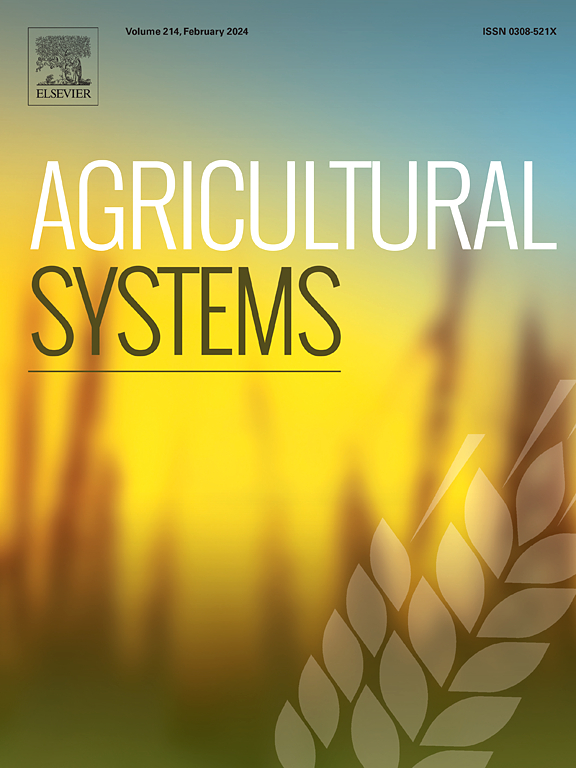The environmental trade-off of fertiliser, residue and catch crop management in Danish cropping systems
IF 6.1
1区 农林科学
Q1 AGRICULTURE, MULTIDISCIPLINARY
引用次数: 0
Abstract
Context
Nitrogen is an essential macronutrient in agriculture, affecting both crop yields and soil health. In Denmark, one of the most densely farmed regions in the world, excess reactive nitrogen (Nr) compounds are lost to the environment along gaseous and hydrological pathways in forms such as nitrate, ammonia, nitrogen oxides and dinitrogen.
Objectives
Here, we aim to assess the effect of different field management practices (fertilisation, crop residue management or cultivation of catch crops) on environmental Nr losses and the field scale soil net GHG balance (i.e., sum of soil C stock changes and direct and indirect N2O emissions).
Methods
For this purpose, highly detailed data from the Danish Agricultural Watershed Monitoring Program (LOOP-program; 2013–2019) were used in combination with the process-based model LandscapeDNDC.
Results and conclusions
The results indicate that a mixture of organic and synthetic fertilisers turns soils to a stronger net sink of GHGs (∼70 – ∼514 kgCO2−eq ha−1 yr−1) compared to exclusive use of only one type of fertiliser. In addition, incorporating crop residue and cultivation of catch crops increases the nitrogen use efficiency (NUE) by 3–11 % on average and decreases environmental Nr losses.
Significance
These findings emphasize the potential of targeted fertiliser, residue and catch crop management to increase the sustainability of crop production systems in Denmark.

丹麦种植系统中肥料、残留物和捕获作物管理的环境权衡
氮是一种重要的农业宏量营养素,影响作物产量和土壤健康。丹麦是世界上农业最密集的地区之一,过量的活性氮(Nr)化合物沿着气体和水文途径以硝酸盐、氨、氮氧化物和二氮等形式流失到环境中。在这里,我们旨在评估不同的田间管理措施(施肥、作物残茬管理或捕捞作物种植)对环境Nr损失和田间土壤净温室气体平衡(即土壤C储量变化和直接和间接N2O排放的总和)的影响。为此,采用丹麦农业流域监测计划(LOOP-program;2013-2019)与基于过程的模型landscape - edndc结合使用。结果和结论:结果表明,与只使用一种肥料相比,有机肥料和合成肥料的混合物使土壤成为更强的温室气体净汇(~ 70 ~ ~ 514 kgCO2−eq ha−1 yr−1)。此外,结合作物残茬和种植捕捞作物可使氮素利用效率(NUE)平均提高3 - 11%,减少环境Nr损失。这些发现强调了有针对性的肥料、残留物和捕获作物管理在提高丹麦作物生产系统可持续性方面的潜力。
本文章由计算机程序翻译,如有差异,请以英文原文为准。
求助全文
约1分钟内获得全文
求助全文
来源期刊

Agricultural Systems
农林科学-农业综合
CiteScore
13.30
自引率
7.60%
发文量
174
审稿时长
30 days
期刊介绍:
Agricultural Systems is an international journal that deals with interactions - among the components of agricultural systems, among hierarchical levels of agricultural systems, between agricultural and other land use systems, and between agricultural systems and their natural, social and economic environments.
The scope includes the development and application of systems analysis methodologies in the following areas:
Systems approaches in the sustainable intensification of agriculture; pathways for sustainable intensification; crop-livestock integration; farm-level resource allocation; quantification of benefits and trade-offs at farm to landscape levels; integrative, participatory and dynamic modelling approaches for qualitative and quantitative assessments of agricultural systems and decision making;
The interactions between agricultural and non-agricultural landscapes; the multiple services of agricultural systems; food security and the environment;
Global change and adaptation science; transformational adaptations as driven by changes in climate, policy, values and attitudes influencing the design of farming systems;
Development and application of farming systems design tools and methods for impact, scenario and case study analysis; managing the complexities of dynamic agricultural systems; innovation systems and multi stakeholder arrangements that support or promote change and (or) inform policy decisions.
 求助内容:
求助内容: 应助结果提醒方式:
应助结果提醒方式:


